Enhancing the Performance of GaN-Based Light-Emitting Diodes by Incorporating a Junction-Type Last Quantum Barrier
Abstract
1. Introduction
2. Device Structure and Parameters
| Parameter | Symbol | Unit | InN | GaN | AlN |
|---|---|---|---|---|---|
| Spontaneous polarization | Psp | C m−2 | −0.042 | −0.034 | −0.09 |
| Piezoelectric constant (z) | e33 | C m−2 | 0.810 | 0.670 | 1.50 |
| Piezoelectric constant (x, y) | e31 | C m−2 | −0.410 | −0.340 | −0.53 |
| Elastic constant | C33 | GPa | 200 | 392 | 382 |
| Elastic constant | C13 | GPa | 94 | 100 | 127 |
| Lattice constant | a0 | Å | 3.548 | 3.189 | 3.112 |
3. Results and Discussion
3.1. Light Output Power
3.2. Energy Band Diagrams
3.3. Carrier Concentration
3.4. Current-Voltage Curves
3.5. Radiative Recombination Rates
3.6. Electroluminescence Spectra
3.7. Electric Fields
4. Conclusions
Author Contributions
Funding
Data Availability Statement
Conflicts of Interest
References
- Liu, Y.; Xia, T.; Du, A.; Liang, T.; Fan, Z.; Chen, E.; Sun, J.; Yan, Q.; Guo, T. Omnidirectional color shift suppression of full-color micro-LED displays with enhanced light extraction efficiency. Opt. Lett. 2023, 48, 1650–1653. [Google Scholar] [CrossRef]
- Zhao, J.; Chen, K.; Gong, M.G.; Hu, W.X.; Liu, B.; Tao, T.; Yan, Y.; Xie, Z.L.; Li, Y.Y.; Chang, J.H. Epitaxial Growth and Characteristics of Nonpolar a-Plane InGaN Films with Blue-Green-Red Emission and Entire In Content Range. Chin. Phys. Lett. 2022, 39, 048101. [Google Scholar]
- Zhuang, Z.; Iida, D.; Ohkawa, K. Investigation of InGaN-based red/green micro-light-emitting diodes. Opt. Lett. 2021, 46, 1912–1915. [Google Scholar] [CrossRef] [PubMed]
- Zhang, Y.Y.; Yin, Y.A. Performance enhancement of blue light emitting diodes with a special designed AlGaN/GaN supperlattice electron- blocking layer. Appl. Phys. Lett. 2011, 99, 221103. [Google Scholar] [CrossRef]
- Schubert, E.F. Light-Emitting Diodes, 2nd ed.; Cambridge University Press: Cambridge, UK, 2006. [Google Scholar]
- Wang, F.; Li, S.-S.; Xia, J.-B.; Jiang, H.X.; Lin, J.Y.; Li, J.; Wei, S.-H. Effects of the wave function localization in AlInGaN quaternary alloys. Appl. Phys. Lett. 2007, 91, 061125. [Google Scholar] [CrossRef]
- Aumer, M.E.; LeBoeuf, S.F.; McIntosh, F.G.; Bedair, S.M. High optical quality AlInGaN by metalorganic chemical vapor deposition. Appl. Phys. Lett. 1999, 75, 3315–3317. [Google Scholar] [CrossRef]
- Kuo, Y.K.; Tsai, M.C.; Yen, S.H. Numerical simulation of blue InGaN light-emitting diodes with polarization-matched AlGaInN electron-blocking layer and barrier layer. Opt. Commun. 2009, 282, 4252–4255. [Google Scholar] [CrossRef]
- Lin, Z.; Wang, H.; Chen, S.; Lin, Y.; Yang, M.; Li, G.; Xu, B. Achieving High-Performance Blue GaN-Based Light-Emitting Diodes by Energy Band Modification on AlxInyGa1−x−yN Electron Blocking Layer. IEEE Trans. Electron Devices 2017, 64, 472–480. [Google Scholar] [CrossRef]
- Gu, W.; Lu, Y.; Lin, R.; Guo, W.; Zhang, Z.-H.; Ryou, J.-H.; Yan, J.; Wang, J.; Li, J.; Li, X. BAlN for III-nitride UV light-emitting diodes: Undoped electron blocking layer. J. Phys. D Appl. Phys. 2021, 54, 175104. [Google Scholar] [CrossRef]
- Xing, Z.; Wang, F.; Wang, Y.; Liou, J.J.; Liu, Y. Enhanced performance in deep-ultraviolet laser diodes with an undoped BGaN electron blocking layer. Opt. Express 2022, 30, 36446–36455. [Google Scholar] [CrossRef]
- Yang, G.; Tong, Y.; Xie, F.; Yan, D.; Wang, F. Design analysis of polarization-doped N-face InGaN/GaN light-emitting diodes with different AlxGa1−xN graded layers. Mater. Sci. Semicond. Process. 2015, 29, 362–366. [Google Scholar] [CrossRef]
- Usman, M.; Munsif, M.; Anwar, A.R.; Malik, S.; Islam, N.U.; Khan, S. Hole transport enhancement by thickness- and composition-grading of electron blocking layer. Opt. Eng. 2021, 60, 036101. [Google Scholar] [CrossRef]
- Xia, C.S.; Simon Li, Z.M.; Li, Z.Q.; Sheng, Y. Effect of multiquantum barriers in performance enhancement of GaN-based light-emitting diodes. Appl. Phys. Lett. 2013, 102, 013507. [Google Scholar]
- Xing, Z.; Wang, Y.; Wang, F.; Liou, J.J.; Liu, Y. Improvement of the optoelectronic characteristics in deep-ultraviolet laser diodes with tapered p-cladding layer and triangular electron blocking layer. Appl. Phys. B 2022, 128, 197. [Google Scholar] [CrossRef]
- Tian, W.; Liu, M.; Li, S.; Liu, C. Improving the hole injection efficiency in AlGaN DUV LEDs by minimizing the band offset at the p-EBL/hole supplier interface. Opt. Mater. Express 2023, 13, 2449–2459. [Google Scholar] [CrossRef]
- Xia, C.S.; Simon Li, Z.M.; Lu, W.; Zhang, Z.H.; Sheng, Y.; Cheng, L.W. Droop improvement in blue InGaN/GaN multiple quantum well light-emitting diodes. Appl. Phys. Lett. 2011, 99, 233501. [Google Scholar]
- Lin, B.-C.; Chen, K.-J.; Wang, C.-H.; Chiu, C.-H.; Lan, Y.-P.; Lin, C.-C.; Lee, P.-T.; Shih, M.-H.; Kuo, Y.-K.; Kuo, H.-C. Hole injection and electron overflow improvement in InGaN/GaN light-emitting diodes by a tapered AlGaN electron blocking layer. Opt. Express 2014, 22, 463–469. [Google Scholar] [CrossRef] [PubMed]
- Zhang, Z.-H.; Kyaw, Z.; Liu, W.; Ji, Y.; Wang, L.; Tan, S.T.; Sun, X.W.; Demir, H.V. A hole modulator for InGaN/GaN light-emitting diodes. Appl. Phys. Lett. 2015, 106, 063501. [Google Scholar] [CrossRef]
- Bao, X.; Sun, P.; Liu, S.; Ye, C. Performance Improvements for AlGaN-Based Deep Ultraviolet Light-Emitting Diodes With the p-Type and Thickened Last Quantum Barrier. IEEE Photonics J. 2015, 7, 1400110. [Google Scholar] [CrossRef]
- Chu, C.; Tian, K.; Che, J.; Shao, H.; Kou, J.; Zhang, Y.; Li, Y.; Wang, M.; Zhu, Y.; Zhang, Z.H. On the origin of enhanced hole injection for AlGaN-based deep ultraviolet light-emitting diodes with AlN insertion layer in p-electron blocking layer. Opt. Exp. 2019, 27, 620–628. [Google Scholar] [CrossRef]
- Wang, L.-Y.; Song, W.-D.; Hu, W.-X.; Li, G.; Luo, X.-J.; Wang, H.; Xiao, J.-K.; Guo, J.-Q.; Wang, X.-F.; Hao, R.; et al. Efficiency enhancement of ultraviolet light-emitting diodes with segmentally graded p-type AlGaN layer. Chin. Phys. B 2019, 28, 018503. [Google Scholar] [CrossRef]
- Liu, Z.; Yu, H.; Ren, Z.; Dai, J.; Chen, C.; Sun, H. Polarization-engineered AlGaN last quantum barrier for efficient deep-ultraviolet light-emitting diodes. Semicond. Sci. Technol. 2020, 35, 075021. [Google Scholar] [CrossRef]
- Wu, J.; Li, P.; Zhou, X.; Wu, J.; Hao, Y. Increasing the Carrier Injection Efficiency of GaN-Based Ultraviolet Light-Emitting Diodes by Double Al Composition Gradient Last Quantum Barrier and p-Type Hole Supply Layer. IEEE Photonics J. 2021, 13, 1–8. [Google Scholar] [CrossRef]
- Liu, M.; Liu, C. Enhanced Carrier Injection in AlGaN-Based Deep Ultraviolet Light-Emitting Diodes by Polarization Engineering at the LQB/p-EBL Interface. IEEE Photonics J. 2022, 14, 8228005. [Google Scholar] [CrossRef]
- Khan, M.A.; Matsuura, E.; Kashima, Y.; Hirayama, H. Influence of Undoped-AlGaN Final Barrier of MQWs on the Performance of Lateral-Type UVB LEDs. Phys. Status Solidi 2019, 216, 1900185. [Google Scholar] [CrossRef]
- Memon, M.H.; Yu, H.; Jia, H.; Xiao, S.; Wang, R.; Sun, H. Last-Quantum-Barrier-Free AlGaN Deep Ultraviolet LEDs With Boosted Efficiency. IEEE Trans. Electron Devices 2023, 70, 5151–5155. [Google Scholar] [CrossRef]
- Hu, Y.; Wang, J.; Guo, J. Efficiency Enhancement of GaN Based Light-Emitting Diodes with a Heterojunction Type Last Quantum Barrier. In Proceedings of the International Conference on Informatics, Shanghai, China, 2–4 November 2019. [Google Scholar]
- Zhang, Z.-H.; Zhang, Y.; Bi, W.; Geng, C.; Xu, S.; Demir, H.V.; Sun, X.W. On the hole accelerator for III-nitride light-emitting diodes. Appl. Phys. Lett. 2016, 108, 151105. [Google Scholar] [CrossRef]
- Chuang, S.L.; Chang, C.S. A Band-Structure Model of Strained Quantum-Well Wurtzite Semiconductors. Semicond. Sci. Technol. 1997, 12, 252. [Google Scholar] [CrossRef]
- Wang, X.; Jiang, K.; Sun, Z.; Zhang, Z.-H.; Chen, Y.; Wang, B.; Li, D. Valence subbands profile regulation in AlGaN quantum well based on k·p theory. Phys. Scr. 2023, 98, 035103. [Google Scholar] [CrossRef]
- Piprek, J. Semiconductor Optoelectronic Devices: Introduction to Physics and Simulation; Academic Press: Cambridge, MA, USA; UCSB: Santa Barbara, CA, USA, 2003; 22. [Google Scholar]
- Wang, K.; Lian, C.; Su, N.; Jena, D.; Timler, J. Conduction band offset at the InN/GaN heterojunction. Appl. Phys. Lett. 2007, 91, 232117. [Google Scholar] [CrossRef]
- Verzellesi, G.; Saguatti, D.; Meneghini, M.; Bertazzi, F.; Goano, M.; Meneghesso, G.; Zanoni, E. Efficiency droop in InGaN/GaN blue light-emitting diodes: Physical mechanisms and remedies. J. Appl. Phys. 2013, 114, 071101. [Google Scholar] [CrossRef]
- Ambacher, O.; Smart, J.; Shealy, J.R.; Weimann, N.G.; Chu, K.; Murphy, M.; Schaff, W.J.; Eastman, L.F.; Dimitrov, R.; Wittmer, L.; et al. Two Dimensional Electron Gases Induced by Spontaneous and Piezoelectric Polarization in Undoped and Doped AlGaN/GaN Heterosturctures. J. Appl. Phys. 2000, 87, 334–344. [Google Scholar] [CrossRef]
- Fiorentini, V.; Bernardini, F.; Ambacher, O. Evidence for nonlinear macroscopic polarization in III–V nitride alloy heterostructures. Appl. Phys. Lett. 2002, 80, 1204–1206. [Google Scholar] [CrossRef]
- Ridley, B.K.; Schaff, W.J.; Eastman, L.F. Theoretical model for polarization superlattices: Energy levels and intersubband transitions. J. Appl. Phys. 2003, 94, 3972–3978. [Google Scholar] [CrossRef]
- Bernardini, F.; Fiorentini, V.; Vanderbilt, D. Accurate calculation of polarization-related quantities in semiconductors. Phys. Rev. B 2001, 63, 193201. [Google Scholar] [CrossRef]
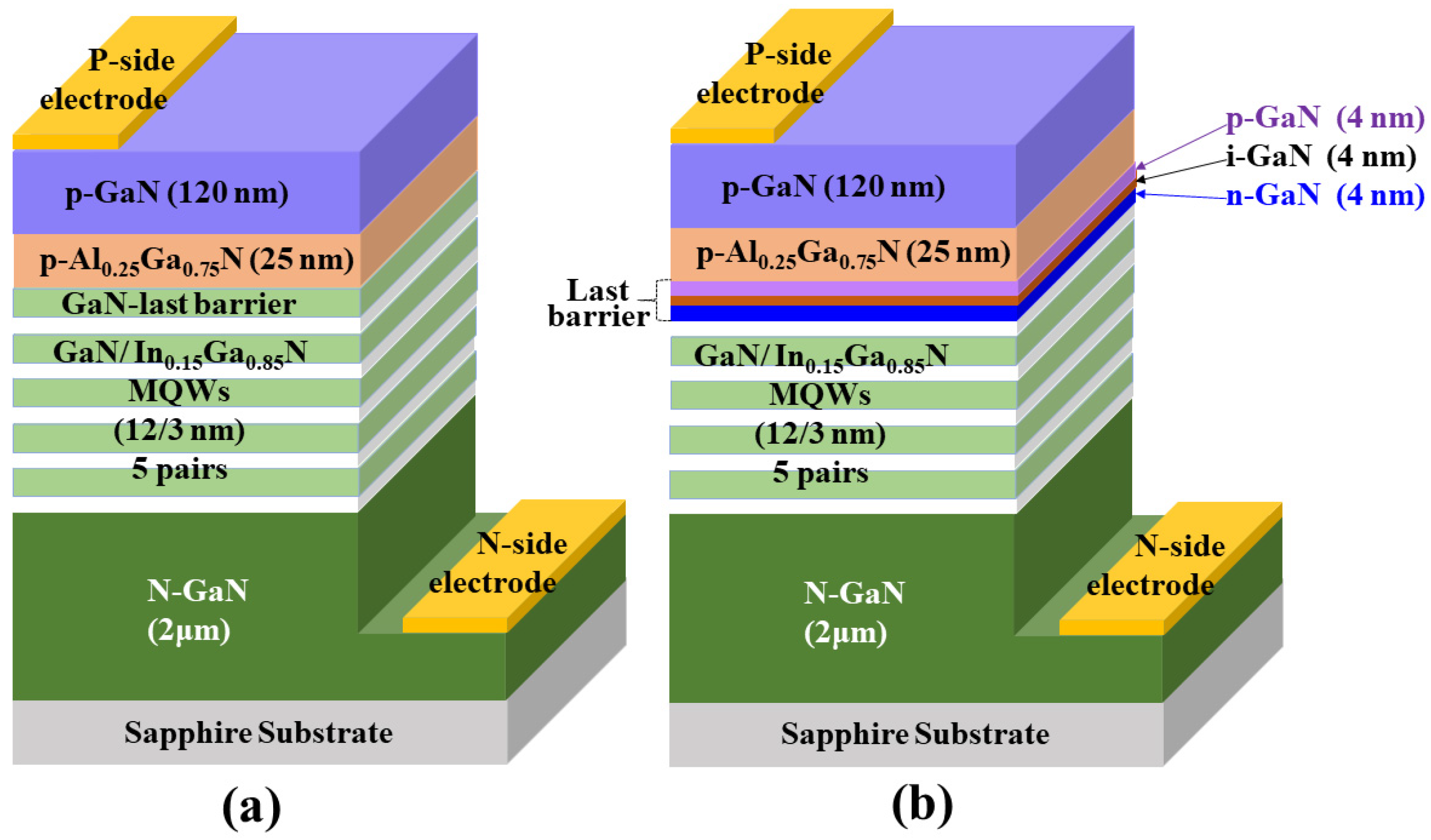
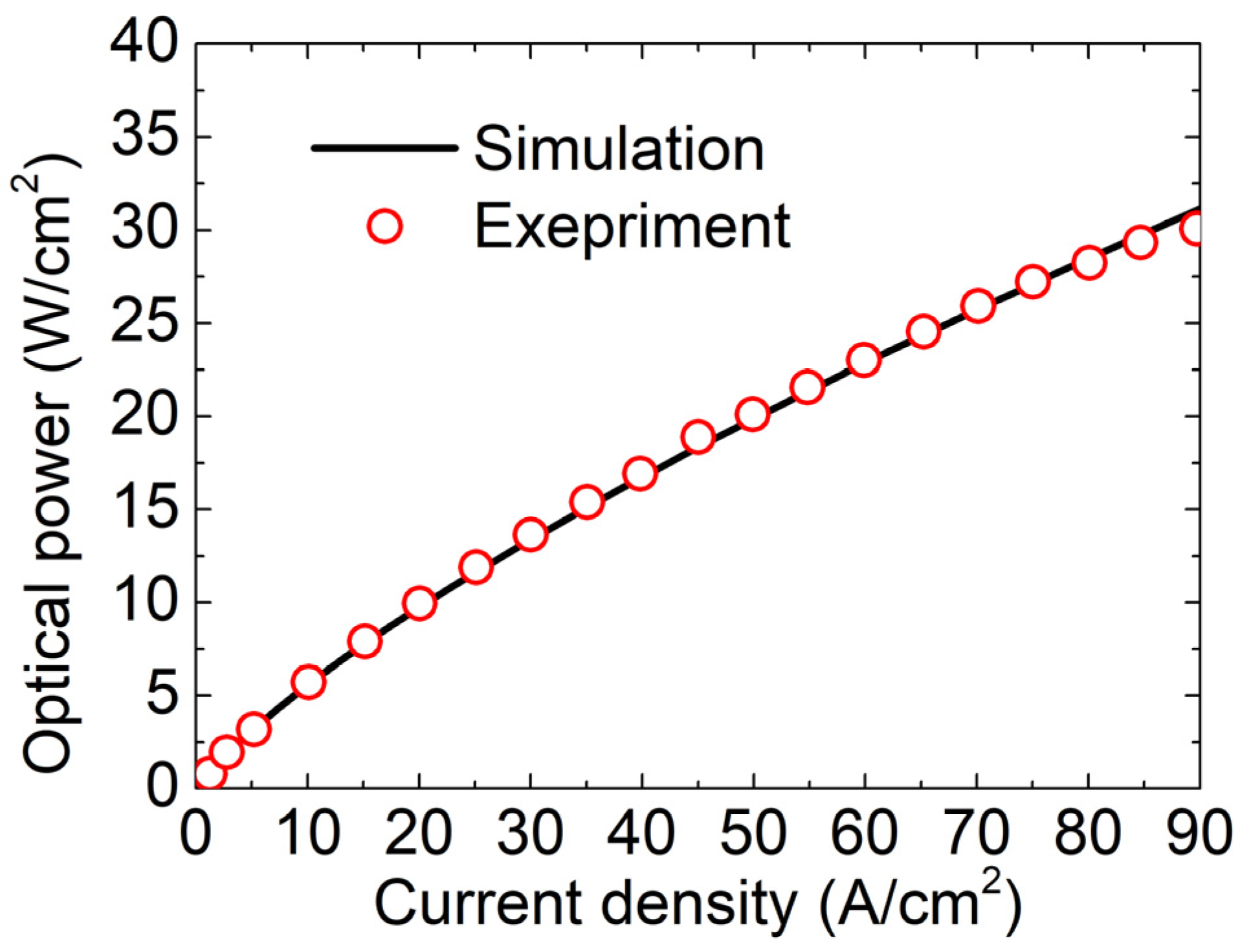
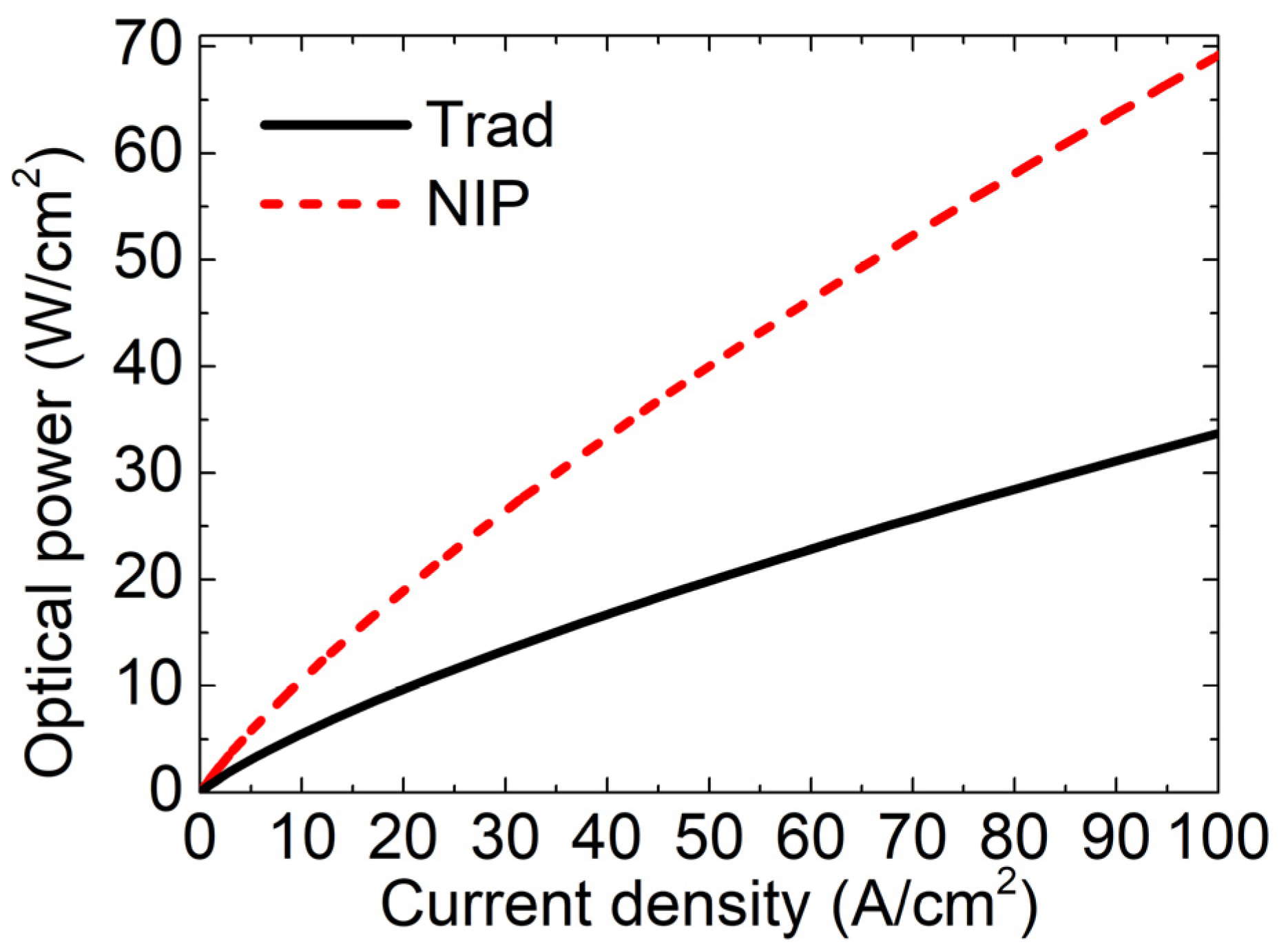


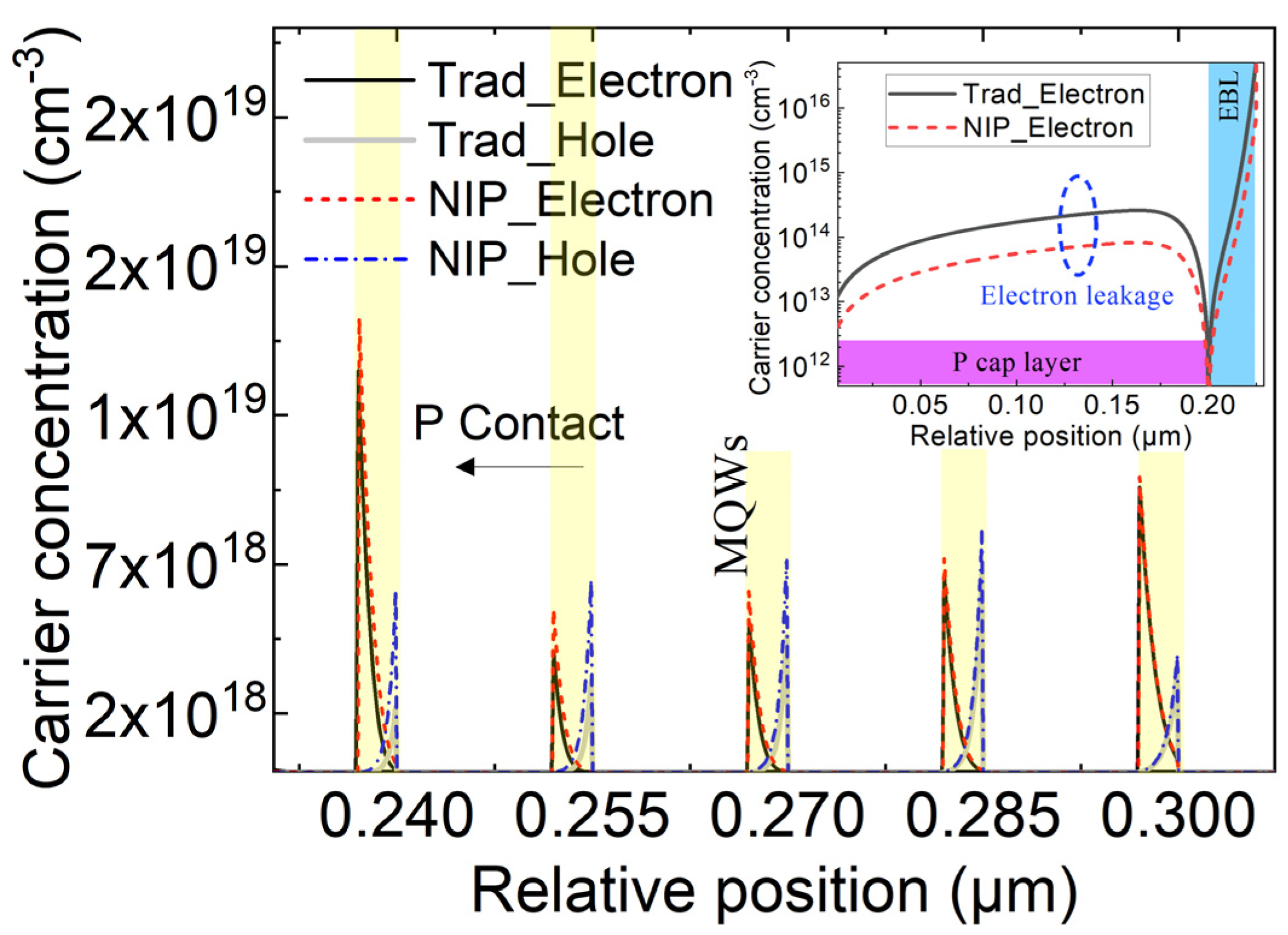
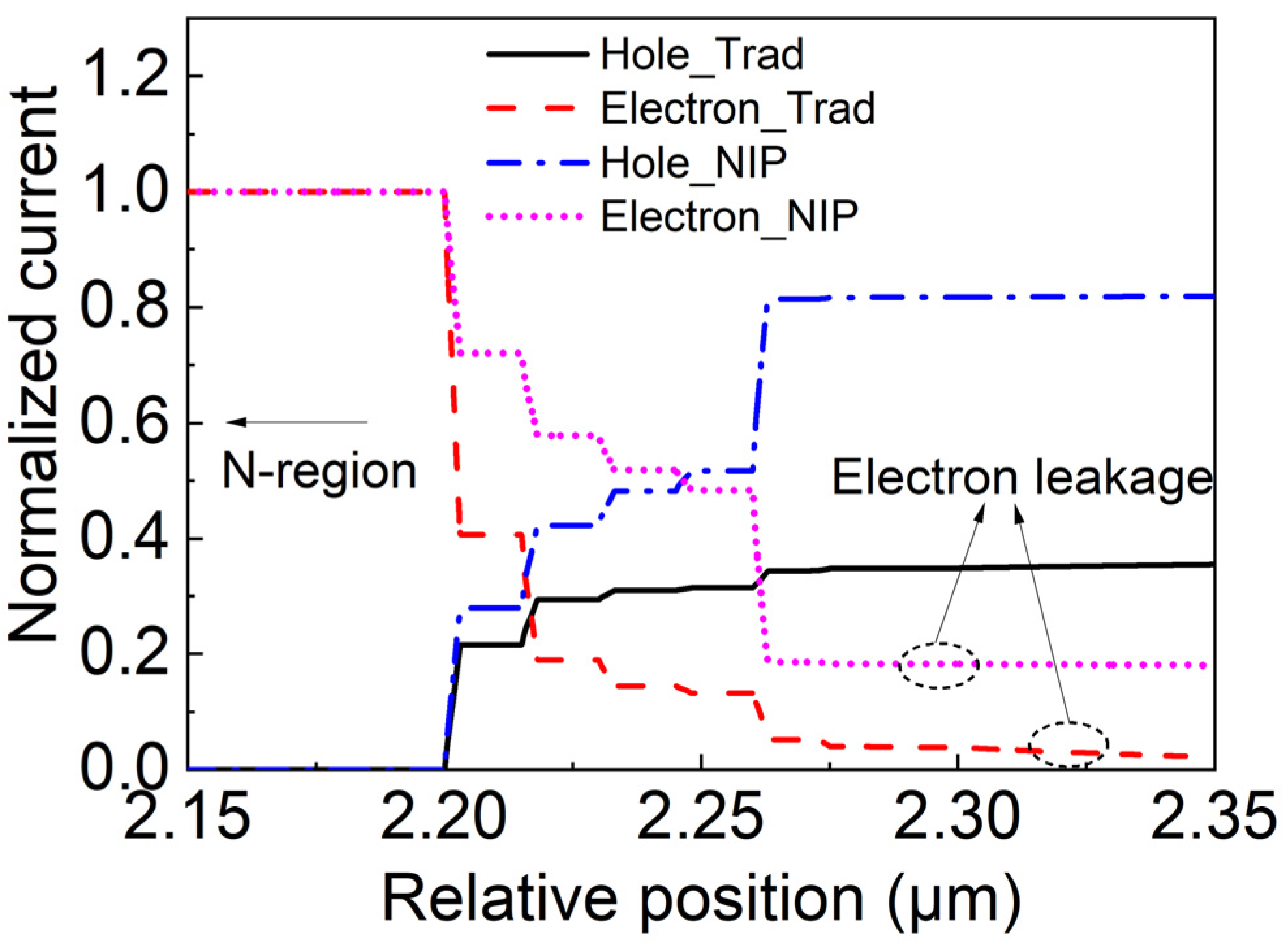
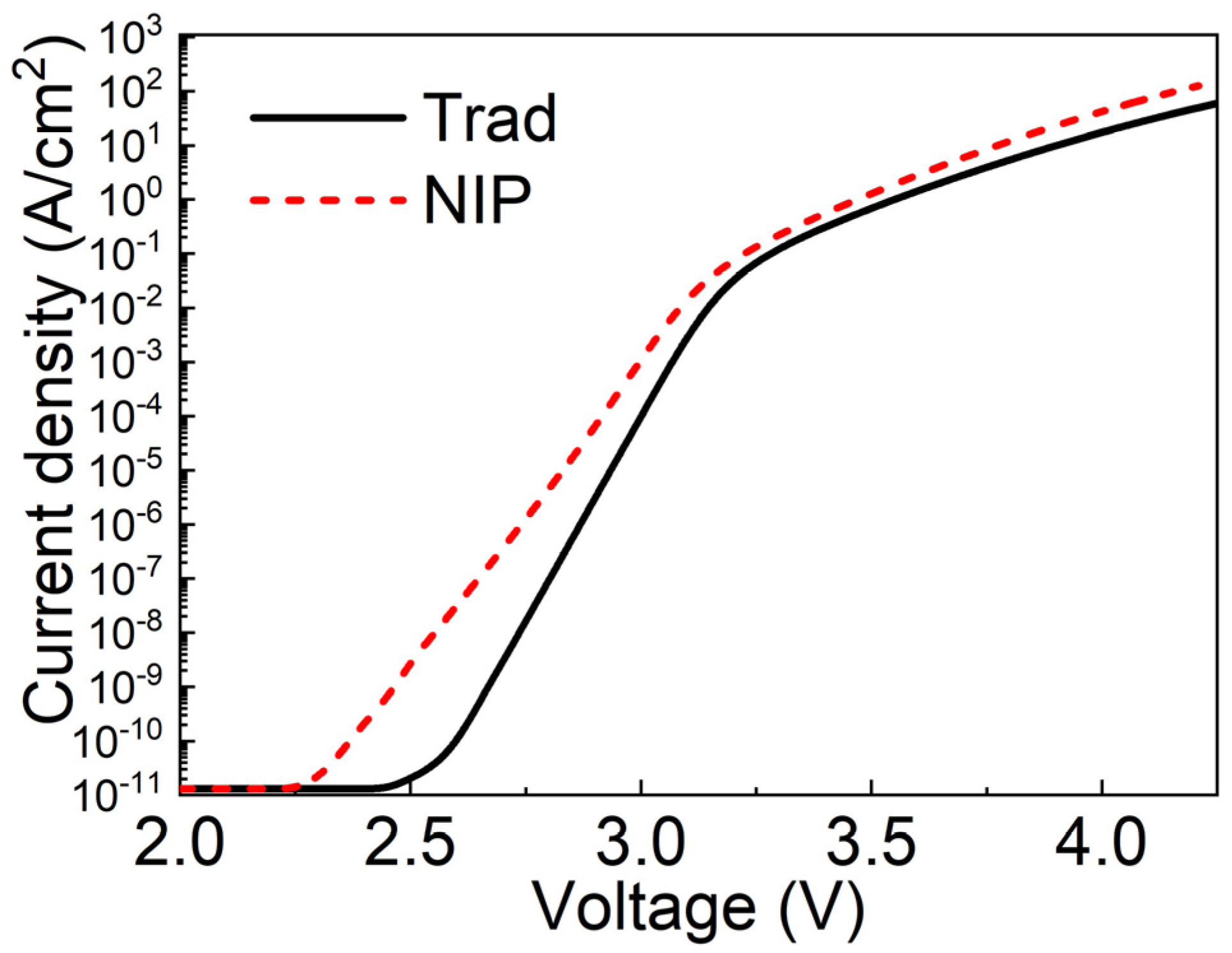

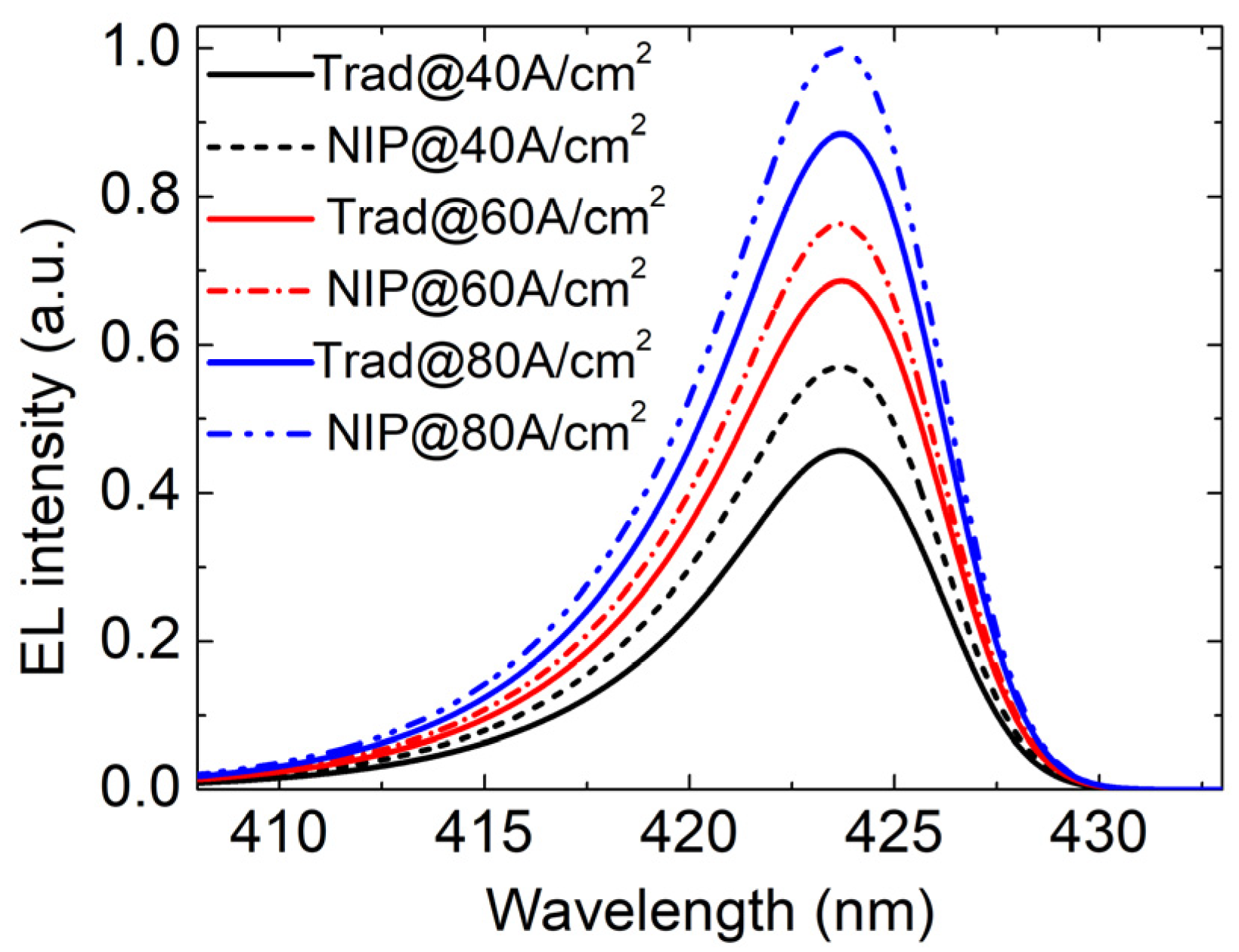
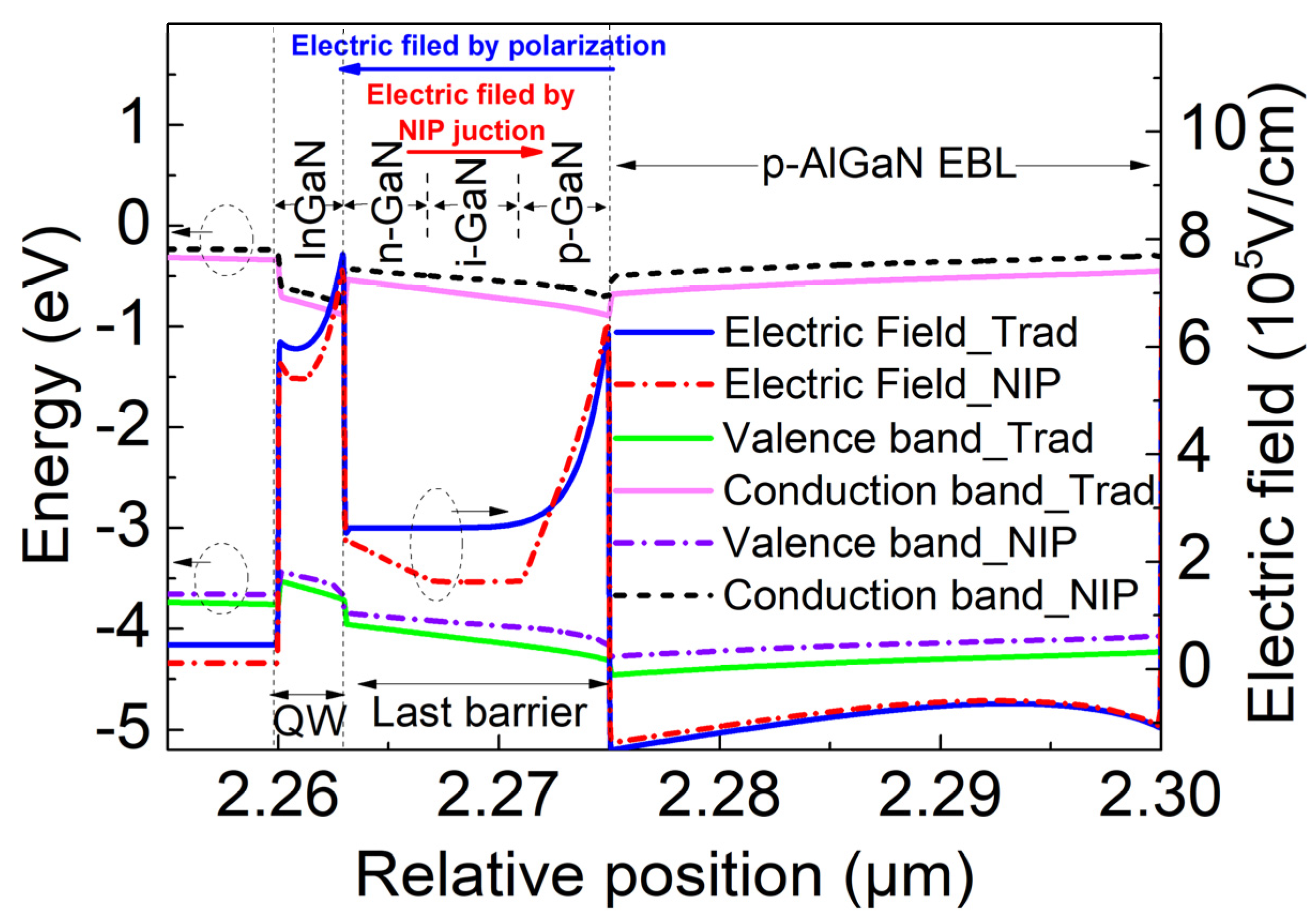
Disclaimer/Publisher’s Note: The statements, opinions and data contained in all publications are solely those of the individual author(s) and contributor(s) and not of MDPI and/or the editor(s). MDPI and/or the editor(s) disclaim responsibility for any injury to people or property resulting from any ideas, methods, instructions or products referred to in the content. |
© 2024 by the authors. Licensee MDPI, Basel, Switzerland. This article is an open access article distributed under the terms and conditions of the Creative Commons Attribution (CC BY) license (https://creativecommons.org/licenses/by/4.0/).
Share and Cite
Wang, J.; Xu, Y.; Wang, X.; Xu, Z.; Gong, M. Enhancing the Performance of GaN-Based Light-Emitting Diodes by Incorporating a Junction-Type Last Quantum Barrier. Electronics 2024, 13, 1399. https://doi.org/10.3390/electronics13071399
Wang J, Xu Y, Wang X, Xu Z, Gong M. Enhancing the Performance of GaN-Based Light-Emitting Diodes by Incorporating a Junction-Type Last Quantum Barrier. Electronics. 2024; 13(7):1399. https://doi.org/10.3390/electronics13071399
Chicago/Turabian StyleWang, Jun, Yiman Xu, Xiaofei Wang, Zuyu Xu, and Maogao Gong. 2024. "Enhancing the Performance of GaN-Based Light-Emitting Diodes by Incorporating a Junction-Type Last Quantum Barrier" Electronics 13, no. 7: 1399. https://doi.org/10.3390/electronics13071399
APA StyleWang, J., Xu, Y., Wang, X., Xu, Z., & Gong, M. (2024). Enhancing the Performance of GaN-Based Light-Emitting Diodes by Incorporating a Junction-Type Last Quantum Barrier. Electronics, 13(7), 1399. https://doi.org/10.3390/electronics13071399








